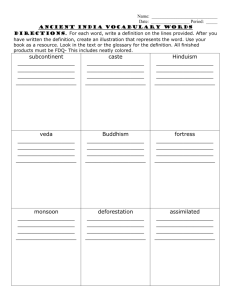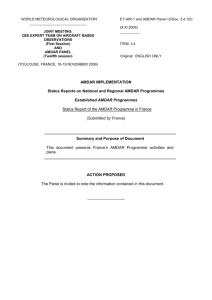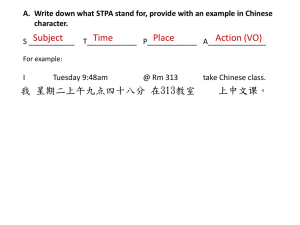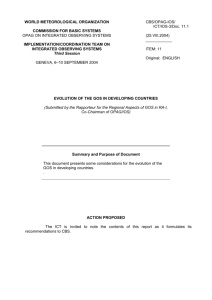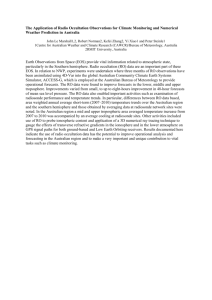In-situ report Precipitation Surface Temperature and humidity
advertisement
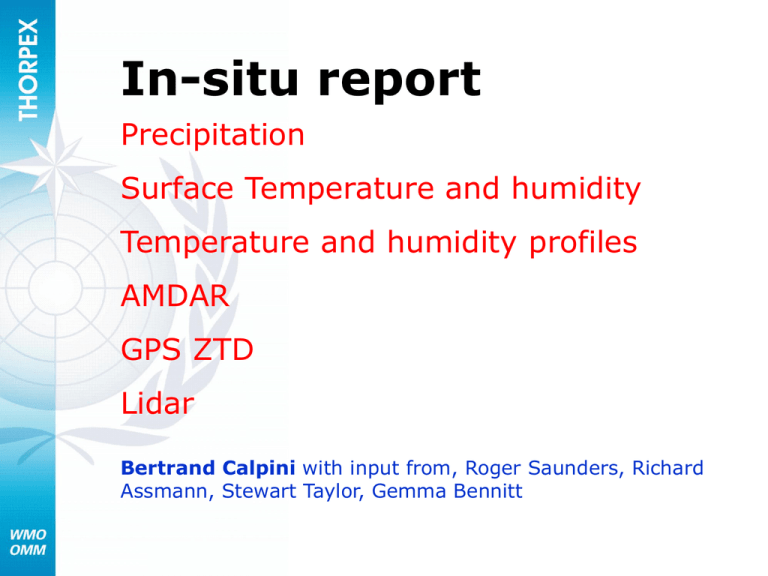
In-situ report Precipitation Surface Temperature and humidity Temperature and humidity profiles AMDAR GPS ZTD Lidar Bertrand Calpini with input from, Roger Saunders, Richard Assmann, Stewart Taylor, Gemma Bennitt 1. Rainfall Intensity • Final report on the WMO CIMO webpage Rain security network in the Alps / 2010 Rain security network in the Alps / 2013 2. Temperature and RH Field Intercomparison of Thermometer Screens/Shields and Humidity Measuring Instruments (17*2 screens) SDAV VROT VTHY VYOU SCAE VDAV LBOM LLAN SYOU LCOC VEIG SSOC -1.5 Screen/Shield VYO U2 VYO U1 VTHY2 VTHY1 VRO T1 VFIS2 VFIS1 VEIG 21 VEIG 12 VEIG 11 VD AV2 VD AV1 SYO U2 SYO U1 SWIN 2 SWIN 1 SVAI2 SVAI1 SSO C2 SSO C1 SD AV2 SD AV1 LSO C LLAN 2 LLAN 1 LCAS LBO M ATHI2 ATHI1 Temperature differences with VEIG22 (°C) 44570 11204 499531 503124 503124 503124 503124 503124 239793 503124 503124 503124 503124 503124 329206 Number of cases Field Intercomparison of Thermometer Screens/Shields and Humidity Measuring Instruments 1.5 1 0.5 0 -0.5 -1 Differences in the time of occurrence of daily maximum temperatures Daily Tx time differences with VEIG22 (minutes) Median 5% - 95% interval 331 331 331 331 331 254 331 331 183 38 42 331 331 SYO U2 VD AV1 VD AV2 VEIG 11 VEIG 12 VEIG 21 VFIS1 VFIS2 VRO T1 VTHY1 VTHY2 VYO U1 VYO U2 266 SVAI2 331 280 SVAI1 SYO U1 331 SSO C2 331 331 SSO C1 SWIN 2 331 SD AV2 331 331 SD AV1 SWIN 1 331 -180 LSO C -150 331 -120 LLAN 2 -90 331 -60 LLAN 1 -30 331 0 LCAS 30 331 60 LBO M 90 87 120 ATHI2 150 91 180 ATHI1 Field Intercomparison of Thermometer Screens/Shields and Humidity Measuring Instruments Number of cases Screen/Shield 25% - 75% interval 0.5% - 99.5% interval Extrem a Gardaia Results • • Even some low-cost screen appear with very good performance Consequences for climate services: – Maximum daily temperature delay: up to 3hrs – Maximum temperature error: up to 1.5deg • Final report on the WMO CIMO webpage 3. Radiosonde 8th WMO International Radiosonde Comparison. Yangjiang, Guangdong, China 12 July – 3 August 2010 Participants: 11 manufacturers from China, Finland, France, Germany, Japan, Korea, South Africa, Switzerland, USA Tropical/subtropical moist conditions Tropopause & 16km Temperature >> -90deg D Temperature D Geopotential Height D Rel Humidity Yangjiang Results • • • • Unprecedented performances achieved with QRS No pressure sensor needed anymore for GPS radiosonde with a direct impact on lowering the cost of radiosonde Intercomparison results used to facilitate selection of systems for national purposes, minimizing additional performance testing on a national level (WTO procedures). Recommendations on vendors to improve their operational radiosonde >>> Final report on the WMO CIMO webpage Met Office MODEM vs Vaisala What is GRUAN? GCOS Reference Upper Air Network Network for ground-based reference observations for climate in the free atmosphere in the frame of GCOS Initially 15 stations, envisaged to be a network of 30-40 sites across the globe See www.gruan.org for more detail GRUAN goals Maintain observations over several decades for accurately estimating climate variability and change Focus on characterizing observational biases, including complete estimates of measurement uncertainty Ensure traceability of measurements by comprehensive metadata collection and documentation Ensure long-term stability by managing instrumental changes Tie measurements to SI units or internationally accepted standards Measure a large suite of co-related climate variables with deliberate measurement redundancy Priority 1: Water vapor, temperature, (pressure and wind) Priority 2: Ozone, clouds, … Monitoring with GPS-RO Vaisala RS92: (COSMIC - RS92)/RS92 SIPPICAN (USA): (COSMIC – SIPP)/SIPP Co-located COSMIC and radiosonde refractivity (3 hrs, 300 km) Very small bias Sonde’s understimate humidity AMDAR Coverage 13th June 11 E-AMDAR 13th June E-AMDAR Europe 13th June E-AMDAR: Network Developments 1. • 1st Nov 2010 - EZY fleets providing data over UK domain and selected European airports. • Software on coverage BAW A319 (LCY – SNN – JFK). But when ainstalled volcano erupts is reduced! 26 E-AMDAR: WVSS Programme 1. 27 US (NOAA): WVSS Programme 1. 28 Some stats • AMDAR reports from Alaskan Airlines received from 25 March 2011 an extra 110 aircraft reporting ~10% increase in AMDAR reports globally • 230 dropsonde reports over North Pacific during March 2011 – good quality • 57% reduction of Canadian AMDARs over 2 years, but levelled-off recently • New Canadian ADS data received from 4 March 2011 over western North Atlantic Ground-based GPS Observations available from E-GVAP http://egvap.dmi.dk Ground-based GPS NAE and UK models: • ~18 000 zenith total delay (ZTD) observations assimilated into NAE model per day, ~1400 in UK models. • Recent study focusing on heavy rainfall events with UK4 model showed 10.9% increase in ETS for 6 hour precip accumulation when ZTDs assimilated. Global model: • Trials of assimilating ZTD into global NWP model underway • Met Office and Czech republic now produce global near real-time ZTD observations (not yet available on GTS) Testbeds and Leadcenters Met office Observation Monitoring – some notable events 2010/11 • Volcanic ash episode in April 2010: few AMDARs, but more TEMPs - looked for changes in temperature bias at TEMP stations (as biased AMDARs removed) - no significant changes seen • Loss of ~40% Canadian sonde winds due to demise of Loran-C on 1/08/10 - impact minimised by CMC producing winds at either 00Z or 12Z at nearby stations • Antarctic Concordiasi campaign Sep-Nov 2010 - 560 dropsondes received and assimilated at the Met Office - >50000 balloon winds + temps received/assimilated from 19 gondola balloons • AMDAR data over UK increased by 65% on 1/11/10 due to EasyJet data (for a 6-month trial period) - quality similar to other E-AMDAR data • E-AMDAR processing problems 28-29 Nov 2010 - few AMDARs on 28 Nov, but old data queued & sent on 29 Nov, resulting in rms o-b vector wind 50% higher (10% for assim’d data) than usual in 12UTC run & probable degradation in forecast • 2 Greenland stations’ TEMP reports corrupted since January 2011 - data missing 700-100hPa from stations 04220 & 04270 at Met Office (& MeteoFrance) due to coding errors in reports • Winds from 102 European wind profilers/weather radars now assimilated at Met Office - Norwegian WRWP wind quality improved in spring 2010, but Spanish WRWP quality still poor (no Finnish winds assimilated 2 Nov – 8 Dec 2010, as profiles received in reverse height order) Issues for NWP • Transition to BUFR for radiosondes provide new opportunities • Global GPS total zenith delay • In-situ soil moisture and temp • Common format for precip radar data •To improve estimates of solid precipitation and develop guidance on the accuracy and temporal resolution of solid precipitation parameters • New observations needed for mesoscale DAOS-WG statement on need for additional in-situ observations There is increasing evidence based upon results from A-TREC, TPARC, AMMA (in the form of OSEs, adjoint-based observation impact studies, and analysis uncertainty estimates) to recommend, if feasible, increases in observations from: • Commercial aircraft over the N. Pacific, N. Atlantic, and the S. Hemisphere in general. • Additional soundings from certain coastal radiosondes, including those in eastern Siberia, and perhaps selected stations in polar regions, Africa, and South America. to improve NWP forecasts in the 2-5 day timeframe.

